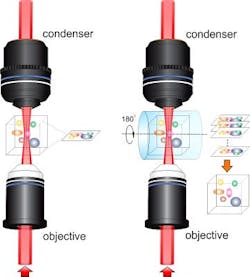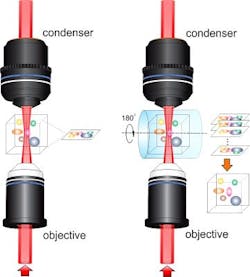Volumetric imaging method may eliminate need to draw blood
A system that pairs stimulated Raman projection microscopy and tomography, and uses a special type of laser beam to penetrate deep into tissue, might lead to technologies that eliminate the need to draw blood for drug testing and early disease detection.
Related: Converting molecular vibration to mechanical for deep-tissue imaging
The system enables volumetric imaging without using fluorescent dyes that might affect biological functions and hinder accuracy, says Ji-Xin Cheng, a professor in Purdue University's Weldon School of Biomedical Engineering, Department of Chemistry, and Birck Nanotechnology Center. "Volumetric chemical imaging allows a better understanding of the chemical composition of three-dimensional (3D) complex biological systems such as cells," he says.
The technology uses a Bessel beam, which maintains focus for a longer distance than a traditional Gaussian beam used in other imaging technologies, making it possible to penetrate deep into tissue. Stimulated Raman spectroscopy eliminates the need for fluorescent dyes. The technology yields more accurate data than other methods because it allows imaging of the entire cell by adding up signals produced from the scanning beam, Cheng says.
The Bessel beam is produced using a pair of cone-shaped axicon lenses and is combined with a microscope objective. Its use for volumetric fluorescence imaging was previously demonstrated by physicist Eric Betzig, who won the Nobel Prize in chemistry in 2014 for his pioneering contribution to super-resolution microscopy. Super-resolution technology allows researchers to resolve structural features far smaller than the wavelength of visible light, sidestepping the diffraction limit that normally prevents imaging of features smaller than about 250 nm, which is large compared to certain biological molecules and structures in cells.
However, fluorescence microscopy usually requires the use of fluorescent tags, which may interfere with biological processes and hinder accuracy for determining chemical structure.
Future research will include work to increase the detection sensitivity of the system and improve the imaging quality and speed. "The system is based on a bulky and relatively expensive femtosecond laser, which limits its potential for broad use and clinical translation," Cheng explains. "Nevertheless, we anticipate that this limitation can be circumvented through engineering innovations to reduce the cost and size of our technology. We also note that the Bessel beam can be produced using fibers, which could simplify the system and enable endoscopic applications."
Full details of the work appear in the journal Nature Communications; for more information, please visit http://dx.doi.org/10.1038/ncomms15117.

